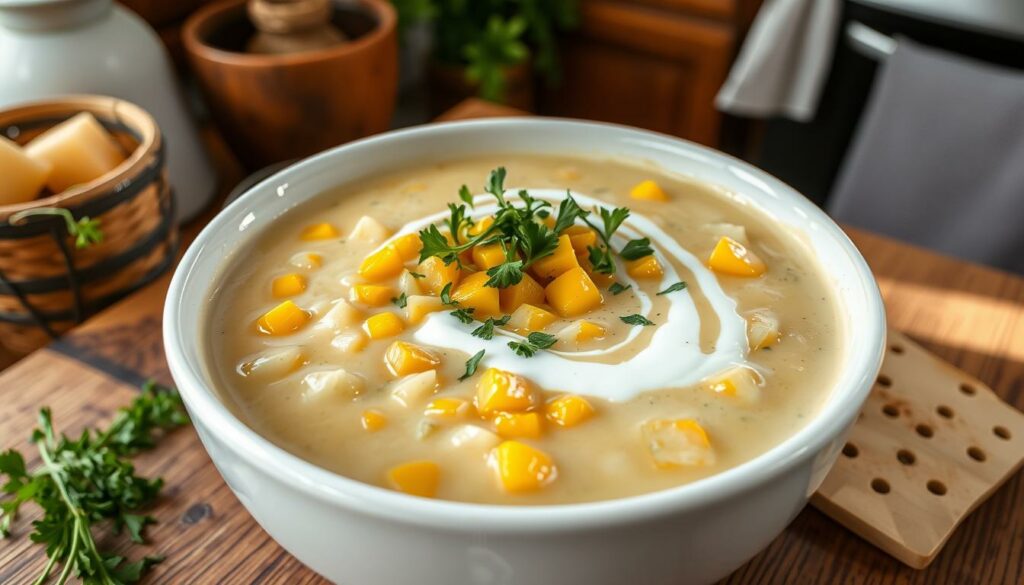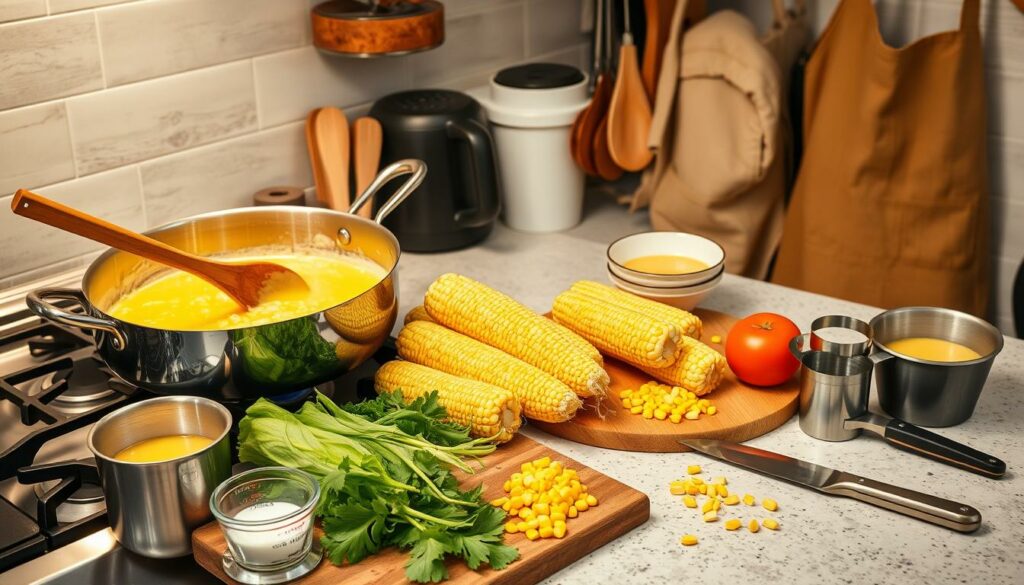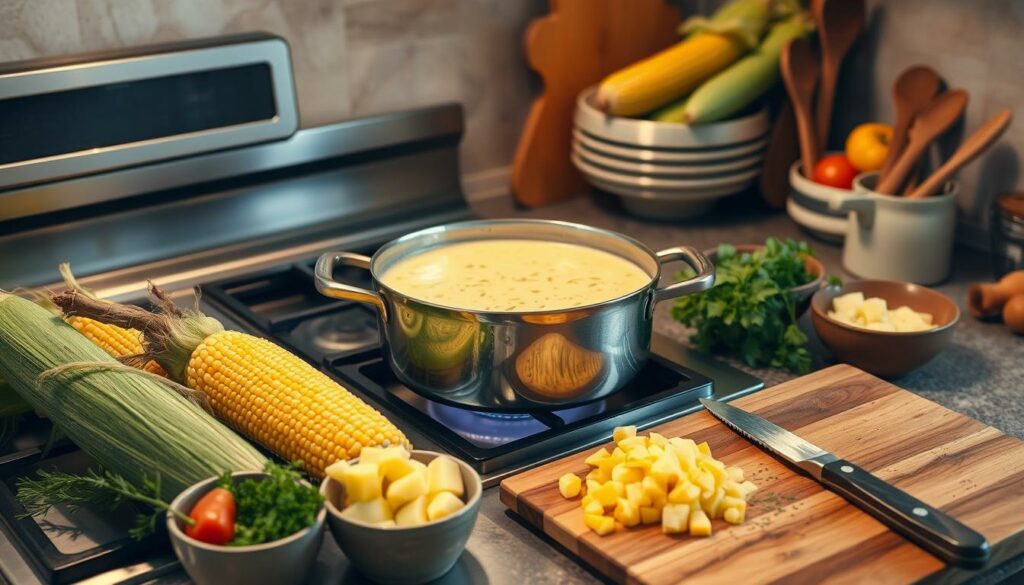Indulge in the comforting and creamy goodness of a homemade corn chowder. This classic soup combines the sweetness of fresh corn kernels, the heartiness of potatoes, and the savory flavors of bacon and onions, creating a dish that’s perfect for cozy evenings and chilly days. With its velvety texture and blend of vibrant ingredients, this corn chowder recipe is a true delight for the senses and a guaranteed crowd-pleaser.
Prepare to be transported to a warm and inviting kitchen, where the aroma of this simmering soup will fill the air and transport you to a state of pure culinary bliss. Whether you’re a seasoned home cook or a beginner in the kitchen, this corn chowder recipe is easy to follow and promises to deliver a comforting and satisfying meal in under an hour.

Key Takeaways
- Creamy and comforting corn chowder recipe
- Combines the sweetness of corn, the creaminess of potatoes, and the savory flavors of bacon and onions
- Easy to prepare, with a total cooking time of under an hour
- Perfect for cozy evenings and chilly days
- A crowd-pleasing classic soup that’s sure to delight the senses
Understanding the Origins of Traditional Corn Chowder
Corn chowder, a quintessential dish in New England cuisine, has deep roots that trace back to the region’s rich culinary heritage. This beloved soup has evolved over centuries, reflecting the unique cultural influences and environmental factors that have shaped the region’s traditional recipes.
New England’s Contribution to Chowder History
The origins of corn chowder can be found in the early colonial settlements of New England, where local ingredients and indigenous cooking techniques were combined to create nourishing and satisfying meals. The Native American tribes, such as the Wampanoag and Narragansett, played a crucial role in introducing corn and other indigenous ingredients to the European settlers, laying the foundation for the development of chowder recipes.
As the New England colonies grew and prospered, chowder recipes continued to evolve, with each coastal community adding its own unique twist. Variations emerged, incorporating local seafood, vegetables, and regional spices, resulting in a diverse tapestry of chowder styles that continue to captivate food enthusiasts today.
Evolution of Modern Corn Chowder
The modern corn chowder we know and love has undergone a remarkable transformation, adapting to changing tastes and culinary trends over time. While the core ingredients and methods remain rooted in traditional New England cuisine, contemporary chefs and home cooks have experimented with new flavor combinations, cooking techniques, and presentation styles, breathing fresh life into this timeless dish.
From the use of locally sourced, seasonal ingredients to the incorporation of global influences, the evolution of corn chowder has solidified its place as a beloved and versatile dish in the pantheon of American regional cuisines. Today, corn chowder continues to captivate and inspire culinary enthusiasts, who find joy in exploring its rich history and diverse flavors.
Essential Ingredients for Perfect Corn Chowder Recipe
Crafting the ultimate corn chowder starts with carefully selecting the right ingredients. From fresh corn and creamy potatoes to savory bacon and rich heavy cream, each component plays a vital role in creating the perfect balance of flavors and textures.
At the heart of this classic dish are fresh corn kernels, which lend a sweet, juicy burst to every spoonful. Paired with starchy potatoes, they provide the satisfying substance that makes corn chowder so comforting. Crispy bacon adds a delightful smoky note, while onions, celery, and garlic build a flavorful aromatic base.
To achieve the signature creamy richness, a generous amount of heavy cream is incorporated, seamlessly blending with the other ingredients. A careful selection of seasonings, such as salt, pepper, and fresh herbs, rounds out the ensemble, ensuring the flavors harmonize perfectly.
| Ingredient | Role |
|---|---|
| Fresh Corn | Provides sweet, juicy flavor and texture |
| Potatoes | Lend starchy substance and creaminess |
| Bacon | Adds a savory, smoky element |
| Onions, Celery, Garlic | Create a flavorful aromatic base |
| Heavy Cream | Imparts rich, creamy texture |
| Seasonings | Balance and enhance the overall flavor |
With these essential ingredients, you can craft a corn chowder that is both comforting and irresistibly delicious. The key is to thoughtfully consider the role of each component and how they work together to create a harmonious and satisfying dish.
Kitchen Tools and Equipment Needed
Preparing a delectable corn chowder requires the right set of kitchen tools and equipment. From the essential soup pot to the versatile wooden spoon, having the proper cooking equipment on hand can make all the difference in the final dish.
Must-Have Utensils
- Large soup pot or Dutch oven: This is the foundation for your corn chowder, allowing you to simmer the ingredients to perfection.
- Sharp chef’s knife: A high-quality knife is essential for efficiently cutting the vegetables into even, bite-sized pieces.
- Cutting board: Provide a stable, safe surface for chopping and dicing your ingredients.
- Wooden spoon: This classic tool is perfect for stirring and scraping the bottom of the pot, ensuring even cooking and preventing sticking.
- Ladle: Use this to serve up your delicious corn chowder with ease.
Optional Kitchen Gadgets
While the essentials above are must-haves, there are some additional kitchen tools that can simplify the corn chowder-making process:
- Immersion blender: This handy tool allows you to puree a portion of the chowder directly in the pot, creating a creamier texture.
- Vegetable peeler: Quickly peel potatoes and other vegetables with this nifty gadget.
- Measuring cups and spoons: Ensure accurate measurements of all your ingredients for consistent results.
Cooking Vessels Recommended
When it comes to the perfect cooking vessel for corn chowder, a few options stand out:
| Vessel | Benefit |
|---|---|
| Heavy-bottomed soup pot | Distributes heat evenly, preventing hot spots and scorching. |
| Dutch oven | Retains heat well, ideal for long simmering and slow cooking. |
| Stainless steel or enameled cast-iron | Durable and easy to clean, these materials are perfect for corn chowder. |

Preparing Your Vegetables and Base Ingredients
Crafting a delectable corn chowder begins with the careful preparation of your vegetables and base ingredients. This step sets the foundation for a harmonious blend of flavors, so let’s dive in and explore the process of vegetable preparation, mise en place, and chopping techniques.
Start by thoroughly washing all your vegetables, ensuring they are clean and ready for the next step. Onions, celery, and potatoes are the backbone of this chowder, so pay extra attention to properly preparing them.
- Peel and finely dice the onions, aiming for uniform pieces that will cook evenly.
- Slice the celery stalks into thin, bite-sized pieces, revealing their crisp, fresh texture.
- Peel and cube the potatoes, selecting a starchy variety that will lend body to the chowder.
Practicing mise en place, or having all your ingredients prepped and ready before you begin cooking, is crucial for efficient and stress-free chowder preparation. Measure out your vegetable stock, heavy cream, and seasonings, ensuring everything is within reach.
| Ingredient | Preparation |
|---|---|
| Onions | Finely diced |
| Celery | Sliced into thin pieces |
| Potatoes | Peeled and cubed |
| Vegetable Stock | Measured and ready |
| Heavy Cream | Measured and ready |
| Seasonings | Measured and ready |
With your vegetable preparation and mise en place complete, you’re now poised to commence the chowder-making process. By following these essential steps, you’ll ensure a smooth and efficient cooking experience, allowing the flavors to harmonize and create a truly remarkable corn chowder.
Step-by-Step Cooking Instructions
Crafting the perfect corn chowder is a delightful culinary journey that requires attention to detail and a mastery of cooking techniques. Let’s dive into the step-by-step instructions that will guide you towards creating a truly exceptional corn chowder.
Creating the Perfect Base
Begin by sautéing diced bacon in a large pot over medium heat until crispy. Once the bacon is golden, remove it from the pot and set it aside, reserving the rendered fat. In the same pot, sauté diced onions in the bacon fat until they are translucent and fragrant, about 5 minutes. This combination of bacon and onions lays the foundation for the rich, flavorful soup base.
Adding Vegetables and Seasonings
- Next, add diced potatoes, fresh or frozen corn kernels, and chicken or vegetable broth to the pot. Bring the mixture to a gentle simmer and let it cook for 15-20 minutes, or until the potatoes are tender.
- Stir in heavy cream or half-and-half, simmering techniques to allow the flavors to meld.
- Season the chowder with salt, black pepper, and any additional herbs or spices of your choice, such as thyme, bay leaves, or paprika.
Final Cooking Stages
In the final stages of the cooking instructions, you’ll want to taste the chowder and adjust the seasoning as needed. If the chowder is too thick, add a bit more broth to achieve your desired consistency. Conversely, if it’s too thin, let it simmer for a few more minutes to allow the starch from the potatoes to thicken the broth.
Once the chowder is perfectly seasoned and has reached the desired thickness, stir in the reserved crispy bacon pieces. This final touch adds a delightful crunch and depth of flavor to the dish.

By following these step-by-step instructions, you’ll be well on your way to creating a corn chowder that is sure to impress your family and friends. Savor the rich, creamy broth, tender vegetables, and the irresistible combination of flavors that make this dish a true comfort food classic.
Tips for Achieving the Perfect Consistency
Crafting the ideal corn chowder requires more than just assembling the right ingredients. Achieving the perfect soup thickness and creamy texture is an art that can be mastered with a few simple thickening techniques. Whether you prefer a chunky or smooth chowder, the key is finding the right balance to delight your taste buds.
One effective way to thicken your corn chowder is by using a potato masher. As the chowder simmers, gently mash some of the potatoes against the side of the pot. This will release starch, helping to create a creamy texture without compromising the soup thickness. For an even more velvety consistency, you can also purée a portion of the chowder in a blender or food processor before returning it to the pot.
If you find your chowder is still too thin, try incorporating a bit of cornstarch. Mix a tablespoon or two of cornstarch with an equal amount of water to form a slurry, then gently stir it into the simmering chowder. The cornstarch will act as a thickening agent, helping to achieve your desired soup thickness. Be cautious, however, as too much cornstarch can result in a gloppy, overly-thickened consistency.
Balancing the creamy texture and soup thickness is all about experimentation and adjusting to your personal preferences. Start with a thinner consistency and gradually thicken as needed, keeping in mind that the chowder will continue to thicken as it cools. With a little practice, you’ll be able to create the perfect corn chowder time and time again.
“The true secret to a delicious corn chowder lies in finding the perfect balance between creaminess and texture.”
Variations and Customization Options
While the classic corn chowder recipe is a beloved staple, there’s no need to limit yourself. Explore the world of variations and customizations to suit your dietary preferences and seasonal cravings.
Dietary Modifications
For our health-conscious readers, the good news is that this corn chowder can easily be adapted to accommodate vegetarian and gluten-free diets. Simply substitute the chicken stock with a high-quality vegetable broth, and swap out the dairy products for plant-based alternatives like almond or coconut milk.
- Vegetarian Corn Chowder: Use vegetable broth and omit the bacon or sausage.
- Gluten-Free Corn Chowder: Replace the all-purpose flour with a gluten-free flour blend.
Seasonal Adaptations
One of the joys of cooking is embracing the bounty of seasonal ingredients. As the calendar changes, so can your corn chowder. Experiment with adding fresh, in-season vegetables like zucchini, bell peppers, or even sweet potatoes to create a chowder that celebrates the flavors of the moment.
| Season | Seasonal Additions |
|---|---|
| Spring | Asparagus, green peas, fresh herbs |
| Summer | Corn, tomatoes, bell peppers |
| Fall | Butternut squash, kale, sweet potatoes |
| Winter | Potatoes, carrots, celery |
With a little creativity and an open mind, your corn chowder can evolve with the changing seasons, ensuring a fresh and flavorful experience all year round.
Storage and Reheating Guidelines
Properly storing and reheating your leftover corn chowder is essential for preserving its delicious flavor and texture. Follow these simple guidelines to ensure your leftovers stay fresh and enjoyable.
Refrigerating Leftover Corn Chowder
To store your corn chowder in the refrigerator, transfer the cooled soup into an airtight container. It will keep for 3-4 days in the fridge. Be sure to reheat the soup thoroughly before serving, either on the stovetop or in the microwave.
Freezing Corn Chowder
For longer-term storage, corn chowder can be frozen for up to 3 months. Allow the soup to cool completely, then portion it into freezer-safe containers or bags. When ready to enjoy, thaw the chowder in the refrigerator overnight and then reheat it on the stovetop or in the microwave.
Reheating Methods
- Stovetop Reheating: Transfer the chowder to a saucepan and heat over medium, stirring occasionally, until steaming hot throughout.
- Microwave Reheating: Place the chowder in a microwave-safe bowl and heat in 1-minute intervals, stirring between each, until heated through.
Regardless of the reheating method, be sure to stir the chowder thoroughly and check the temperature before serving to ensure it’s piping hot and safe to eat.
| Storage Method | Shelf Life | Reheating Tips |
|---|---|---|
| Refrigerator | 3-4 days | Heat on the stovetop or in the microwave until steaming hot |
| Freezer | Up to 3 months | Thaw in the refrigerator overnight before reheating on the stovetop or in the microwave |
By following these storage and reheating guidelines, you can enjoy your delicious corn chowder leftovers for days to come.
Serving Suggestions and Pairings
Corn chowder is a hearty and satisfying dish that pairs beautifully with a variety of accompaniments. To enhance the dining experience, consider serving your homemade corn chowder with crusty sourdough bread or buttery cornbread. The robust flavors of the chowder will be perfectly complemented by the soft, flavorful bread.
Bread and Side Dishes
A warm, freshly baked loaf of sourdough or a pan of cornbread are excellent choices to soak up the creamy broth and tender corn kernels. For a more substantial meal, you can also serve the chowder alongside a crisp green salad or roasted vegetables to balance the richness of the dish.
Garnishing Ideas
Elevate the presentation and flavor of your corn chowder with creative garnishes. Crispy bacon bits, chopped fresh herbs like chives or parsley, and a swirl of heavy cream or sour cream can all add a delightful finishing touch. These simple yet impactful garnishes will enhance the overall experience and make your corn chowder even more irresistible.





